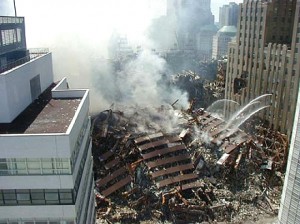2012-04-16: Following the 9-11 World Trade Center Extreme Fire Event, in New York City …
The National Institute of Standards & Technology (NIST), in the USA, recommended that Fire-Induced Progressive Collapse be particularly considered in the case of …
- High-Rise Buildings ;
- Iconic Buildings ;
- Buildings Having a Critical Function ;
- Buildings of Innovative Design.
However, as recently discussed … in order to avoid the wide confusion which the term ‘Fire-Induced Progressive Collapse’ is continuing to cause at international level … the preferred term should now be Fire-Induced Progressive Damage.
AND … CIB Working Commission 14: ‘Fire Safety’ – Research Working Group IV: ‘Structural Reliability & Fire-Induced Progressive Damage’ … would strongly caution that Fire-Induced Progressive Damage and Disproportionate Damage are fundamental concepts to be applied in the design of all building types.
[ A height threshold of 5 Storeys for the consideration of Disproportionate Damage, in the Building Codes/Regulations of many jurisdictions, including Ireland, is entirely arbitrary.]
So … what is Fire-Induced Progressive Damage ? And what is the relationship between this structural concept … and Disproportionate Damage ?
Leaving aside all of the crazy conspiracy theories about the collapse of World Trade Center Building No. 7 … is it possible for Conventional Fire Engineering to directly confront what actually happened ? Unfortunately … the reaction still, even today, is to bury the head, ostrich-like, in the sand … and ignore WTC 7 and the 2008 NIST WTC Recommendations (Final Report NCSTAR 1A) !

.
Yesterday, on an adjoining page here … I uploaded a New CIB W14 International Reflection Document on ‘Structural Reliability & Fire-Induced Progressive Damage’, with 2 Appendices. Scroll down to the section headed ‘April 2012’.
This is a Reflection Document issued by CIB W14 Research Working Group IV: ‘Structural Reliability & Fire-Induced Progressive Damage’; its purpose is to examine the ‘hot form’ structural concept of Fire-Induced Progressive Damage, and to propose a critical update to fire engineering design practice. It is also intended to encourage a wider discussion about some of fire engineering’s fundamental tenets, and the future direction of our profession in a rapidly evolving trans-disciplinary approach to the design, construction and operation of a Safe and Sustainable Built Environment.
The Document is written in a simple, generic language which is accessible to design disciplines outside the International Fire Science and Engineering Community. The next phase of this CIB W14 Innovation & Research Project will certainly require the use of a more technical language, complex calculations, computer modelling, etc … and much closer liaison with CIB W14’s other Research Working Groups on Connections, Design Fires & Design Fire Scenarios, and Performance Criteria.
I wish to sincerely thank those individuals and organizations who have contributed to the work of our Research Working Group IV.
Finally, the myth surrounding NIST’s 9-11 WTC Recommendations, i.e. that they are only applicable in the case of Very Tall Buildings during rarely occurring extreme events … must be completely demolished, and obliterated from the face of the earth !
Climate Change Adaptation is already demanding a much higher level of building resilience.
.
Your Comments on this CIB W14 Reflection Document should be e-mailed to: fireox@sustainable-design.ie
C.J. Walsh, FireOx International – Ireland, Italy & Turkey.
Chair – CIB W14 Research WG IV.
.
.
Update 2012-04-20 …
In response to a discourteous and unprofessional comment about the above CIB W14 WG IV Reflection Document, posted by Mr. Morgan Hurley (Technical Director at the Society of Fire Protection Engineers in the USA) on the LinkedIn SFPE Group WebPage … I wrote, as follows, this morning …
Good Man Morgan !
Relax … there is no need to become defensive quite yet. WG IV’s Reflection Document is simply intended to raise issues … ask questions … and solicit comments from within and, more importantly, from outside the International Fire Science and Engineering Community.
Perhaps of more direct relevance to the SFPE Membership, in the USA, might be the following …
NIST Report: ‘Best Practices for Reducing the Potential for Progressive Collapse in Buildings’ (NISTIR 7396 – February 2007) … is a good document on ‘disproportionate damage’, but it has nothing to say about ‘fire-induced progressive damage’. These two structural concepts are related, but they are not the same.
When discussing Multi-Storey Steel Frame Buildings, on pages 18 and 19, of NIST Report: ‘Best Practice Guidelines for Structural Fire Resistance Design of Concrete and Steel Buildings’ (NISTIR 7563 – February 2009) … what happened to WTC Building 7 on 9-11, and the 2008 NIST WTC Recommendations (NIST NCSTAR 1A), are conveniently and completely ignored. Instead, there is a launch straight into the BRE Fire Tests at Cardington, and computer calculations, in order to justify a very flawed design approach. How crazy is that ?
Hope to see you there next week … we missed you at the last CIB W14 Meeting in Paris !
C.J.
.
.
END

